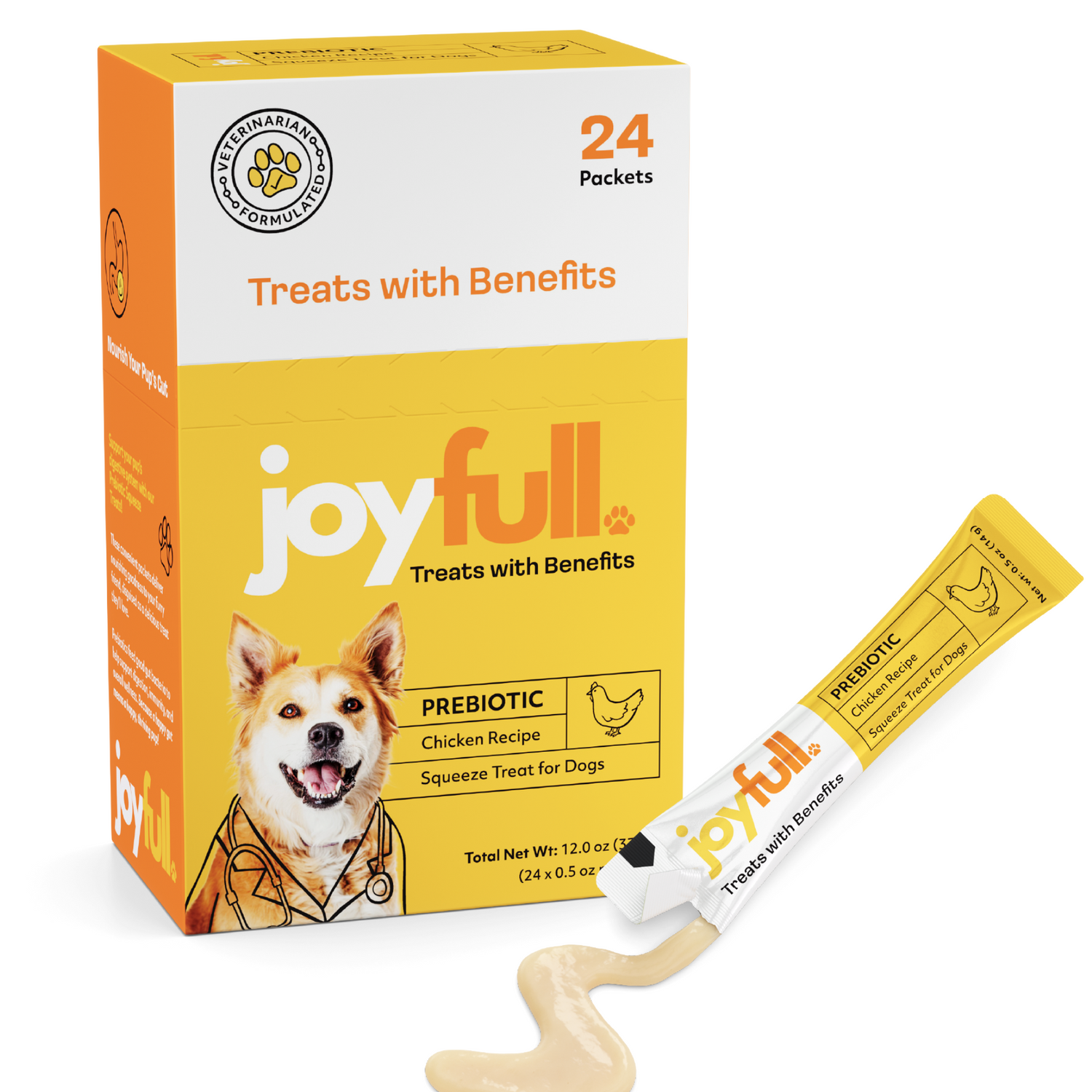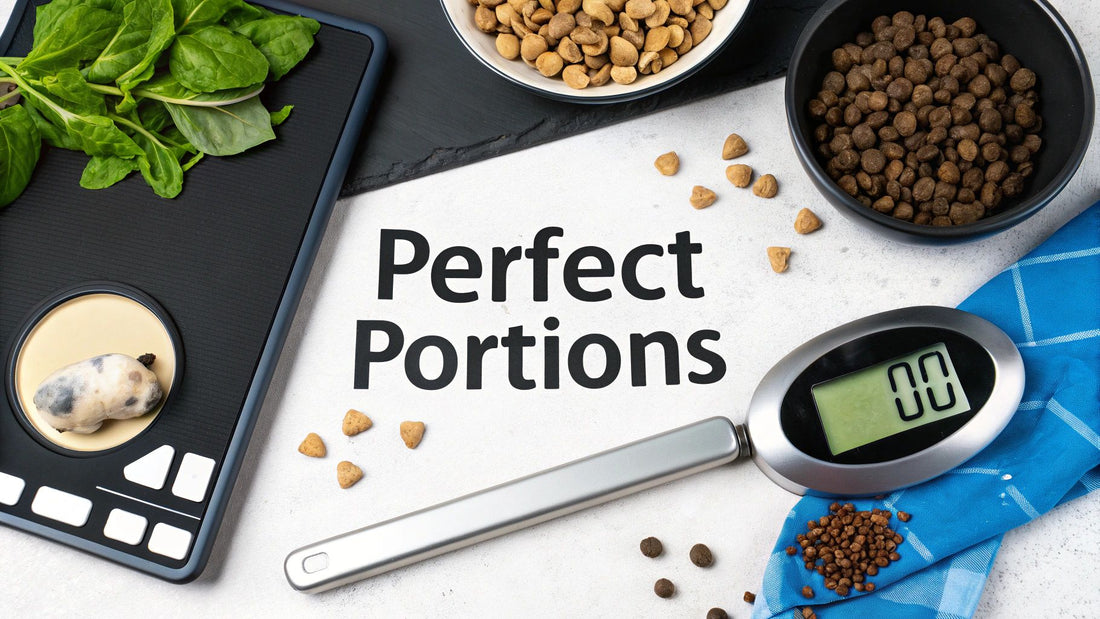
Your Dog Food Portion Calculator Guide
A dog food portion calculator is a smart tool that takes the guesswork out of feeding time. It crunches the numbers for you, using your dog's weight, age, and activity level—plus the specific calorie count of their food—to give you a feeding recommendation tailored just for them. It’s all about swapping assumptions for actual nutritional science to keep your dog in peak condition.
Why Getting Dog Food Portions Right Matters
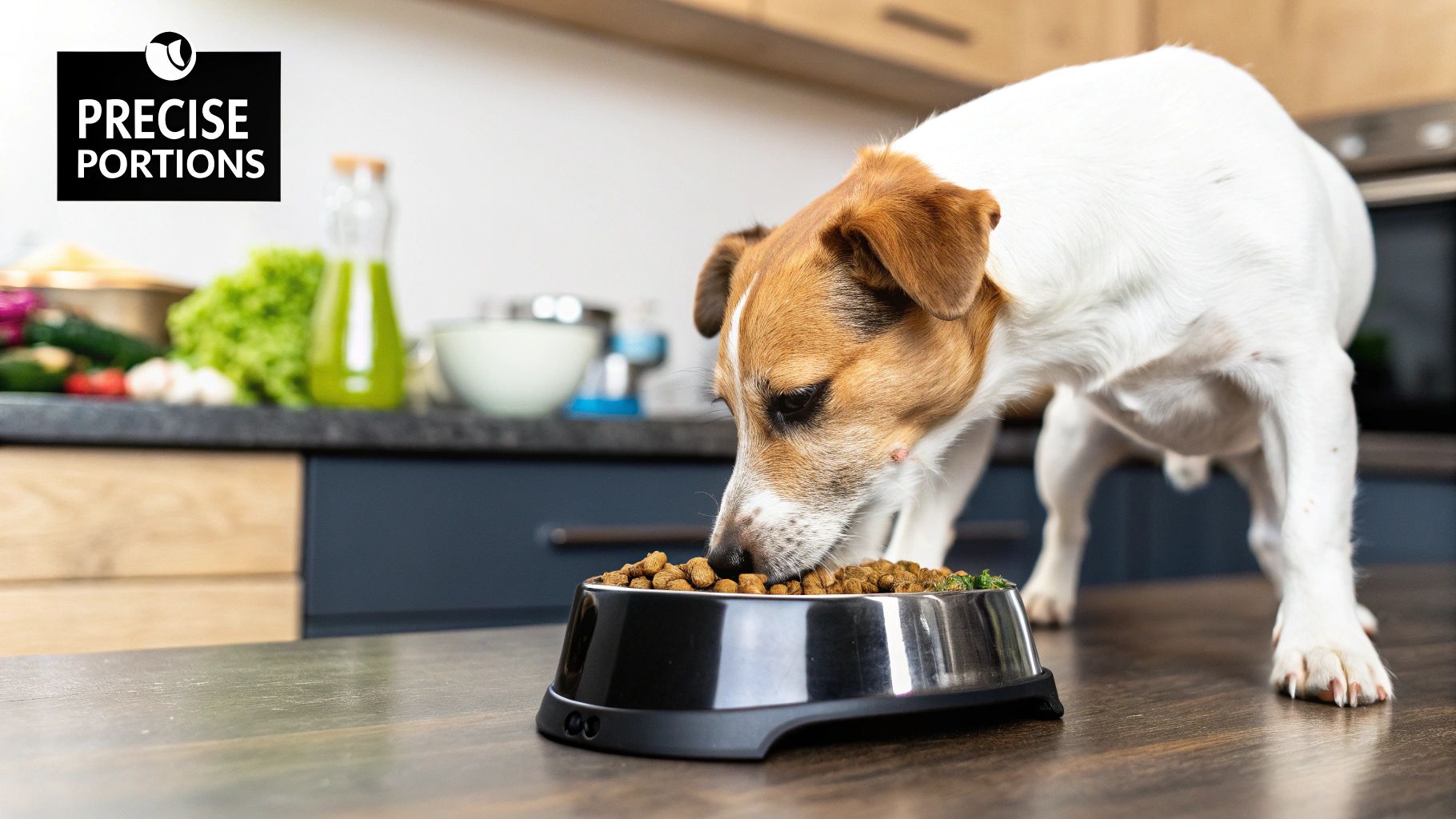
You know that plastic scoop that came free with the giant bag of kibble? It might be convenient, but it's probably causing you to overfeed your best friend. Those scoops, and even the generic feeding chart on the bag, don't account for your dog's unique needs. They treat a couch-potato Basset Hound the same as a hyperactive Border Collie, and that’s a recipe for trouble.
A few extra pieces of kibble at every meal doesn't seem like a big deal, but it adds up fast. Over time, that consistent overfeeding can spiral into serious health issues that diminish your dog's quality of life and can even shorten their lifespan.
The Real-World Impact of Guesswork
Relying on vague guidelines instead of precise calculations has real consequences. Even a little bit of overfeeding day after day is a direct path to pet obesity, which opens the door to a whole host of secondary health problems. These aren't minor aches and pains; they're serious medical conditions that can mean more vet visits and a shorter time with your companion.
Some of the most common fallout from improper portioning includes:
- Increased Strain on Joints: Every extra pound puts immense pressure on your dog's joints, which can lead to or worsen painful conditions like arthritis and hip dysplasia.
- Metabolic and Endocrine Disorders: Obesity is a massive risk factor for developing canine diabetes and other serious hormonal issues.
- Reduced Energy and Vitality: Overweight dogs are often sluggish and less interested in walks or playtime, which impacts their mental and emotional well-being.
The goal isn't just to fill their bowl—it's to fuel their body correctly. Precise portioning is one of the most proactive steps you can take for your dog's long-term health, directly influencing everything from their daily energy to their overall lifespan.
For new pet parents, getting the fundamentals right from the start is critical. Knowing the right questions to ask when adopting a dog, for example, helps lay a foundation for responsible ownership, and that absolutely includes nutrition. As more of us treat our pets like family, the demand for better food standards has skyrocketed. In fact, the dog food market is projected to hit $82 billion by 2026, a boom driven by owners like us who want premium, health-first options for our companions.
Getting the Right Information for Your Dog's Meals
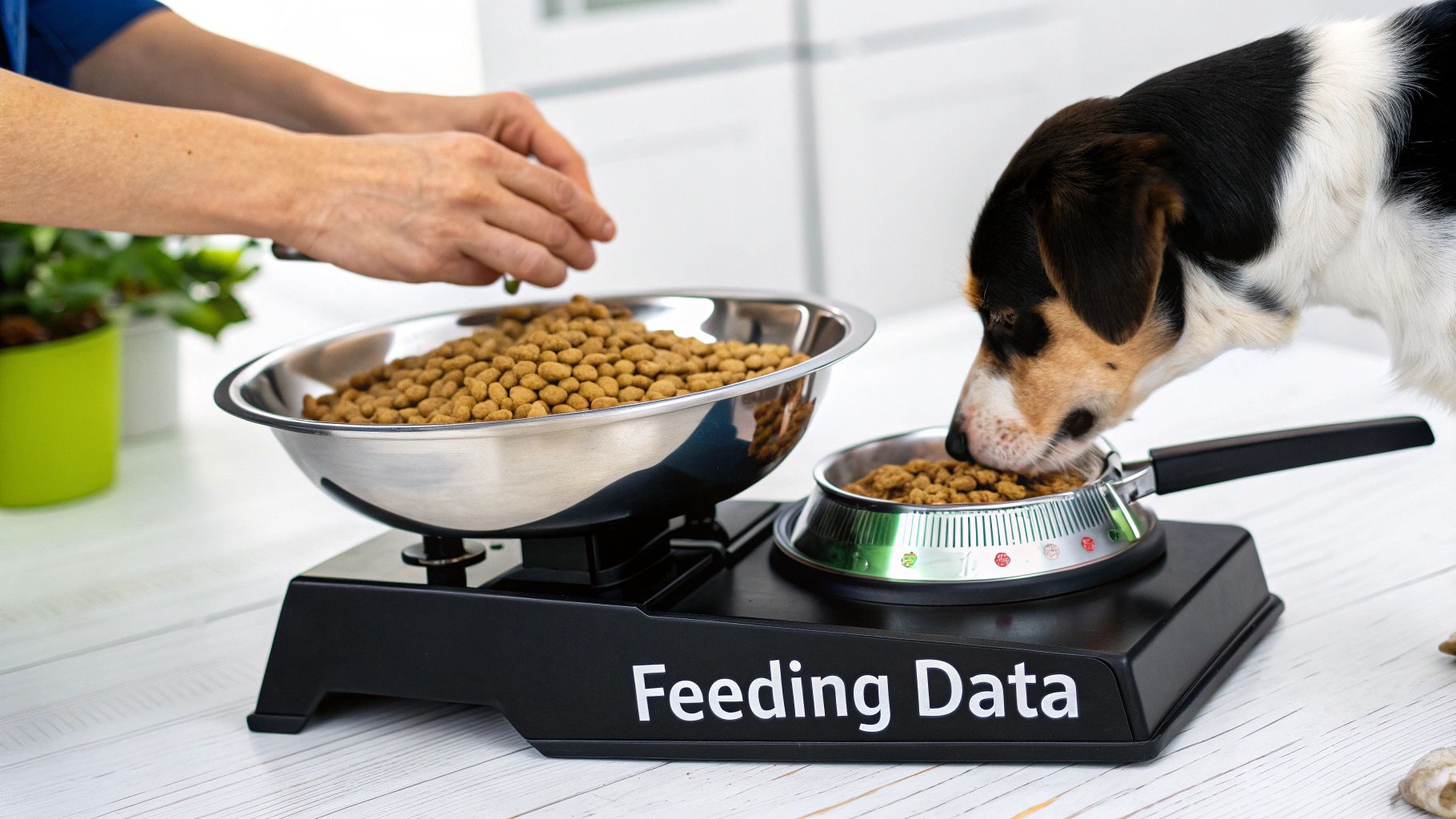
Before you can figure out the perfect portion size, you need to gather a few key details about your dog. Think of it like a chef prepping ingredients—getting these basics right is the secret to a great result. Any dog food calculator is only as good as the information you put into it.
First up is getting an accurate, current weight. This is non-negotiable. For little dogs, the easiest trick is to weigh yourself on a regular bathroom scale, then pick up your pup and weigh both of you. The difference is your dog's weight. If your dog is too big to lift, just pop into your vet's office. They almost always have a walk-on scale in the lobby and are happy to let you use it for free.
It's More Than Just a Number on the Scale
With weight recorded, it's time to assess your dog’s Body Condition Score (BCS). This is a hands-on check that tells you far more than a number alone. You're looking for the sweet spot between too thin and too heavy.
When you gently run your hands over your dog's sides, you should be able to feel their ribs easily under a light layer of fat, but not see them sticking out. From above, they should have a defined "waist" between their ribs and hips. An honest assessment here is crucial for their health.
You also need to be realistic about their activity level. It's so easy to overestimate this! Think about an average day, not their one crazy hour at the dog park.
- Low Activity: Mostly a couch potato. Their idea of a big day is a couple of slow, leisurely walks around the block.
- Moderate Activity: This is most dogs. They get a good daily walk and enjoy a solid 30-60 minutes of playtime, like a game of fetch or a romp at the park.
- High Activity: These are the canine athletes. Think working dogs, agility champs, or your tireless running buddy who joins you on long hikes every weekend.
How much of a difference does activity make? A lot. A sedentary dog might need 20% fewer calories than an average one, while a very active dog could need up to 50% more.
The Final, Crucial Piece of the Puzzle
Last but certainly not least, you need to know the calorie count of their specific food. This is usually listed on the bag as kcal/cup (kcal is just another word for calories). This number is the key that translates their daily calorie needs into an actual serving size.
Sometimes it's buried in the fine print on the nutrition panel. If you're having trouble finding it, our guide on how to read dog food labels has some great tips to help you hunt it down.
The Simple Science Behind Portion Control
Ever wonder what a dog food calculator is actually doing? It's not magic, just some well-established nutritional science. The entire process starts with a baseline number called the Resting Energy Requirement, or RER.
Think of the RER as the bare minimum calories your dog needs just to keep their body running—breathing, thinking, and dreaming of chasing squirrels, all while snoozing on the sofa. It's the energy required for basic survival, and it's calculated with a standard veterinary formula: RER = 70 x (your dog's weight in kg)^0.75.
It might look a little intimidating, but this formula is the most accurate way we have to figure out a dog's foundational metabolic needs.
From a Baseline to Your Dog's Real World
Of course, no dog just lies around all day. This is where we get personal. We take that RER baseline and adjust it for your dog's actual life, giving us their Daily Energy Requirement (DER). This is the real target—the total number of calories they should consume each day.
To get the DER, we multiply the RER by a specific factor that accounts for:
- How active they are: A high-energy Jack Russell has very different needs than a couch-loving Basset Hound.
- Their life stage: A rapidly growing puppy needs more fuel than a settled senior dog.
- If they're spayed or neutered: Neutered dogs can have a slightly slower metabolism, which is an important adjustment to make.
This simple infographic breaks down how it all comes together.
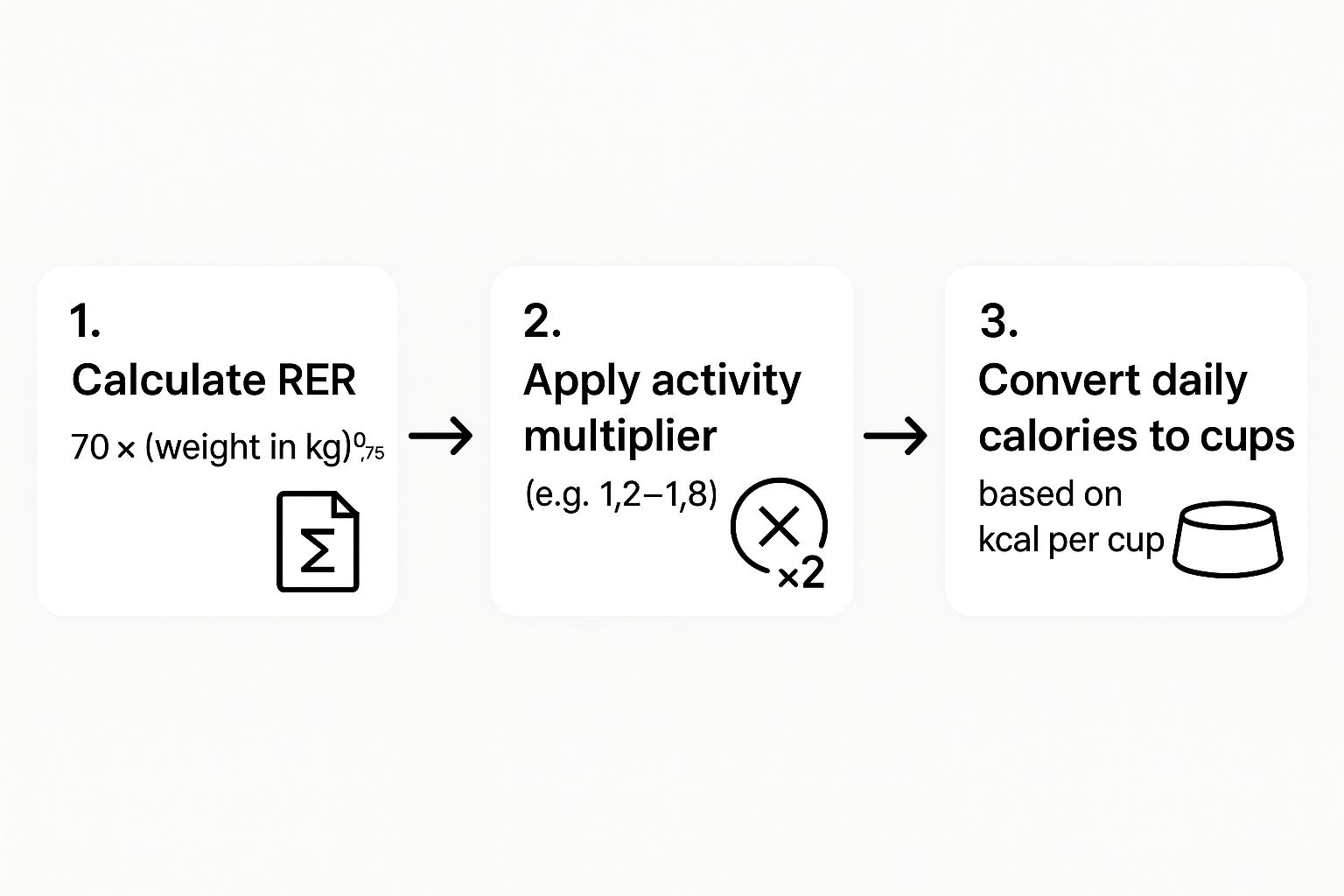
As you can see, it’s a logical flow: we start with the scientific RER, apply a lifestyle multiplier to get a personalized DER, and then translate that calorie number into the right amount of their specific food.
Daily Energy Requirement (DER) Multipliers for Dogs
To really see how this works, veterinarians and nutritionists use a set of standard multipliers. These are the factors that turn your dog's baseline RER into a practical daily calorie goal.
This table provides common multipliers to adjust a dog's Resting Energy Requirement (RER) based on their life stage and activity level, helping calculate their total daily caloric needs.
| Dog's Status | DER Multiplier (Factor x RER) |
|---|---|
| Typical Neutered Adult | 1.6 |
| Typical Intact Adult | 1.8 |
| Weight Loss | 1.0 |
| Weight Gain | 1.5 |
| Active / Working Dogs | 2.0 - 5.0 |
| Puppy (0-4 months) | 3.0 |
| Puppy (4-12 months) | 2.0 |
These numbers are why a young, intact herding dog might need more than double the calories of a neutered adult of the same weight. It’s all about matching energy intake to energy output.
The Bottom Line: A portion calculator's real job is to take the guesswork out of feeding. It translates your dog's individual details—weight, age, and lifestyle—into a clear, science-backed caloric target so you can serve the perfect portion every time.
Calculating and Adjusting Your Dog’s Food
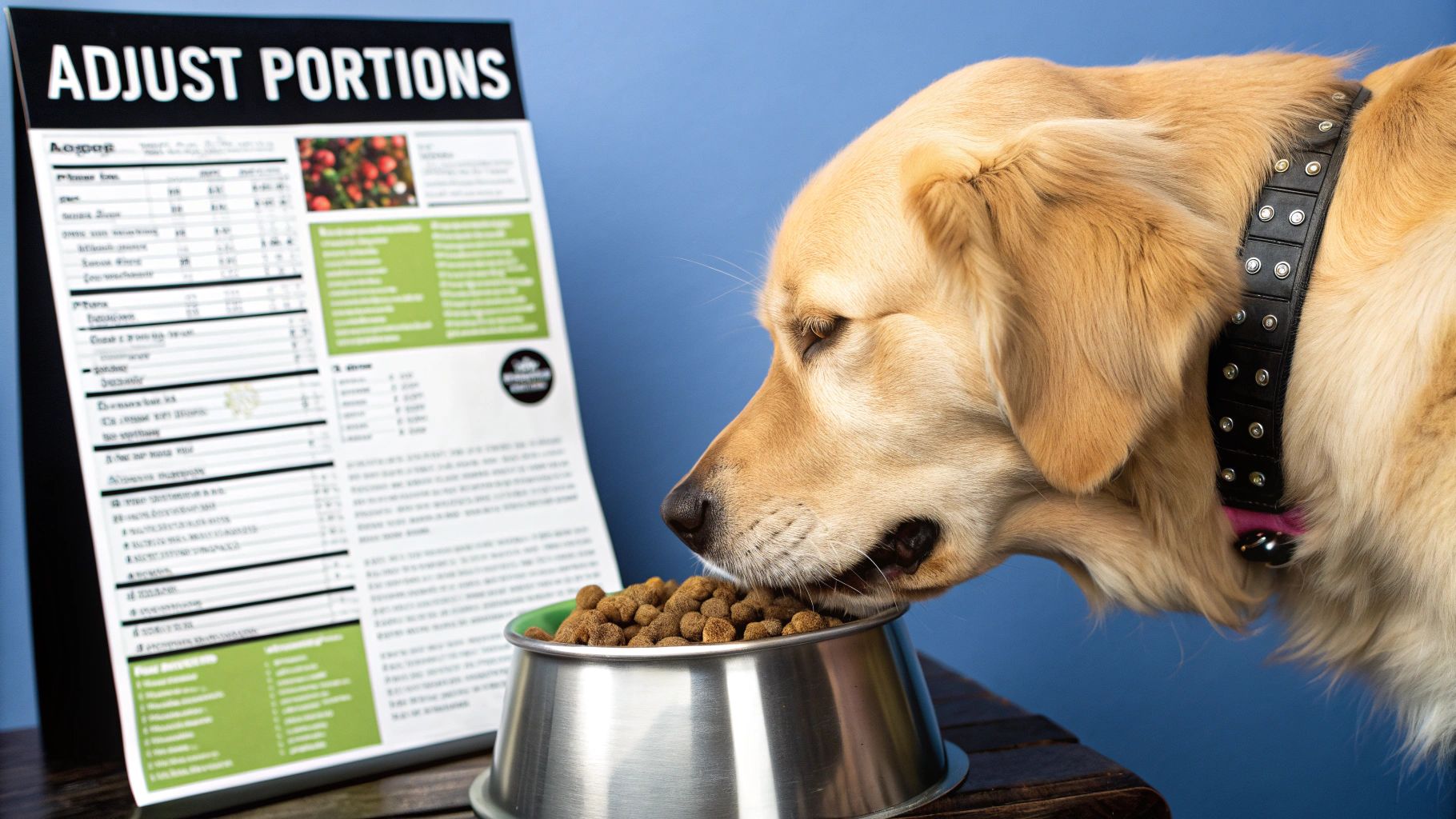
Alright, you’ve got the science down and you've gathered your dog's stats. Now it's time to put it all together. A good dog food calculator gives you a solid scientific baseline, but it's your own careful observation that will truly perfect their meal plan.
Let’s walk through a real-world example. Imagine you have a 50-pound, moderately active Golden Retriever. We'll start by figuring out their Resting Energy Requirement (RER), which comes out to about 660 calories. Because this dog is neutered and gets a good amount of exercise, we'll use a multiplier of 1.6. That gives us a final Daily Energy Requirement (DER) of roughly 1,056 calories.
From Calories to Cups
So, what does 1,056 calories actually look like in their bowl?
Grab your dog's food bag and look for the nutritional information. You’re looking for the kcal/cup value—this tells you how many calories are in one standard measuring cup of that specific kibble.
If your food has 380 kcal per cup, the math is straightforward: divide the total daily calories by the calories per cup.
1,056 calories / 380 kcal per cup = 2.8 cups per day
Most people feed their dogs twice a day, so you’d split that total, giving them around 1.4 cups in the morning and another 1.4 cups in the evening.
This kind of data-driven approach is becoming the new standard, especially with younger generations who grew up with technology at their fingertips.
Generation Z and Millennials are a driving force behind the growth in pet ownership, and this demographic is far more likely to embrace tech-savvy tools like an online dog food portion calculator. These modern tools provide the customized guidance needed for optimal feeding. Discover more insights about the rise of pet tech on petfoodindustry.com.
The Art of Observation and Fine-Tuning
Here’s the most important part: that 2.8 cups is just your starting point. It’s not a rule set in stone. The real magic happens over the next few weeks as you pay close attention to how your dog responds.
Think of it as a feedback loop. You feed them, you observe, and you adjust.
Here’s what to keep an eye on:
- Body Condition: Once a week, do a quick rib check. Can you feel their ribs easily without pressing hard? Do they have a visible waist when you look down at them? If that waist starts to disappear or the ribs get harder to find, it’s time to dial back their daily portion by about 10%.
- Energy Levels: Is your dog suddenly more lethargic or bouncing off the walls? A sudden dip in energy might mean they need a bit more fuel. On the other hand, unusual hyperactivity could mean you’re overdoing it.
- The Scale: Pop them on the scale again in two to four weeks. If their weight is stable, you’ve found the sweet spot. If they’ve gained or lost weight unexpectedly, it’s a clear sign that a small adjustment is needed.
Remember, any adjustments should be gradual. And if you’re making a bigger change, like switching brands, make sure you know how to transition a dog to new food to avoid an upset stomach. You’re the one who knows your dog best, and this process is all about using the numbers as a guide to paint the perfect picture of health.
Life Stages and Special Needs: When to Adjust the Numbers
A dog food calculator is a fantastic starting point, but let’s be real—it's just that, a start. It gives you a solid baseline, but our dogs aren't static creatures. Puppies, seniors, and dogs with health challenges all have unique needs that require a more personalized approach, usually with your vet as your co-pilot.
Think of puppies as tiny, furry furnaces. They are burning through calories at an incredible rate to build bone, muscle, and everything else. It's not just about piling more food in their bowl; it's about giving them nutrient-dense puppy food in three to four small meals spaced throughout the day. This keeps their energy stable and is much easier on their developing digestive systems.
Fine-Tuning Food for Seniors and Health Issues
As our dogs enter their golden years, the opposite happens. Their metabolism starts to slow down, sometimes quite a bit. The same amount of food that kept them fit and trim as an adult can suddenly lead to unwanted pounds, which adds a lot of stress to aging joints. This is where getting portion control just right becomes so important for their comfort and mobility. If your older friend is getting a bit stiff, it's also worth looking into the best vitamins for senior dogs to give their joints some extra support.
Then there are specific health conditions that completely rewrite the rulebook on feeding.
- Weight Management: If your dog is overweight, your vet won't just say "feed less." They'll likely recommend a specific therapeutic diet and a carefully managed plan to help your dog lose weight safely and effectively.
- Diabetes: For a diabetic dog, mealtime becomes a critical part of their medical care. Portions must be exact, the food is often a prescription formula, and timing has to be perfectly synced with insulin injections to keep their blood sugar stable.
For any dog with special health considerations, think of the calculator's recommendation as the opening line in a conversation with your vet. They are the only ones who can help you tailor that baseline to fit your dog's specific medical needs, turning their food into a powerful tool for their well-being.
Answering Your Top Dog Food Portion Questions
Alright, so you've run the numbers through a dog food calculator. That's a huge first step! But now, the real-world questions start popping up. Let's walk through some of the most common things people ask after they get their dog's daily calorie count, so you can feel completely confident about their new meal plan.
Should I Feed My Dog Once or Twice a Day?
This is probably the number one question I get. For almost all healthy adult dogs, splitting their daily food into two meals—one in the morning and one in the evening—is the way to go. It keeps their metabolism steady, helps with digestion, and prevents that "I'm starving!" behavior that leads to scavenging for scraps.
Now, puppies are a whole different ball game. Their tiny stomachs and explosive growth demand more frequent meals. You'll want to feed them three to four smaller meals spread throughout the day to keep them properly fueled.
While you might know someone who feeds their less-active dog just one big meal, two smaller ones are almost always better for their digestive health. In fact, for deep-chested breeds prone to bloat (a very serious medical emergency), vets often recommend multiple small meals to reduce that risk.
The real key? Consistency. Pick a schedule and stick with it. Dogs thrive on routine, and a predictable mealtime can do wonders for their digestion and even their behavior.
How Do I Factor Treats Into My Calculation?
This is the step everyone forgets! Treats have calories, and they absolutely count. A great rule of thumb to live by is the 10% rule.
The 10% Rule: Treats should make up no more than 10% of your dog's total daily calories.
This means you have to do a little math and subtract those treat calories from their main meals. It's not optional if you want to keep their weight on track.
- Let's say your dog needs 800 calories per day.
- Following the 10% rule, they can have up to 80 calories from treats.
- You then need to adjust their main meals to only provide the remaining 720 calories.
Always flip over the treat bag and check the calorie count. If it’s not listed, I’d suggest finding a different treat. This simple habit is crucial for preventing accidental weight gain and keeping your dog's diet balanced.
The Bag Guide vs. My Calculator Result: Which Do I Trust?
Trust your calculator. Every time.
The feeding guides printed on dog food bags are just that—guides. They’re designed to be a one-size-fits-all suggestion, and frankly, they often overestimate how much food a typical house pet really needs. They have to account for the most active dogs out there, which isn't the reality for most of our companions.
Your calculator's result is personalized. It’s based on your dog's specific weight, age, and activity level, making it a much more accurate starting point. Use the amount your calculator gave you, keep an eye on your dog's body condition over the next few weeks, and then you can make small tweaks if needed.
Think of the bag's chart as a generic estimate and your calculation as a personalized prescription for your dog's health.
At Joyfull, we know that getting your dog's nutrition just right is the cornerstone of a long, happy life together. Our formulas are designed to make it simple to feed them the very best.
Find the perfect clean, vet-advised food for your pet at https://joyfullpet.com
